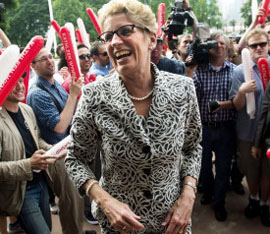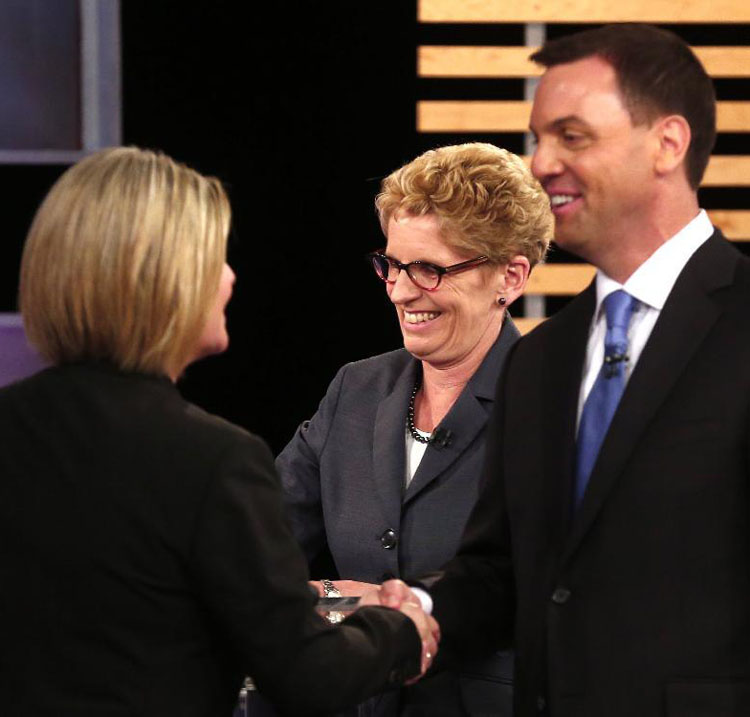Is this the sound of a new long dynasty in Ontario politics settling in ????
Jun 13th, 2014 | By Randall White | Category: In Brief In one way or another history will no doubt record that the Ontario general election of June 12, 2014 was a highly nuanced phenomenon.
In one way or another history will no doubt record that the Ontario general election of June 12, 2014 was a highly nuanced phenomenon.
To start with, Kathleen Wynne’s Liberals have won a six-seat majority in the Legislative Assembly with a mere 39% of the province-wide popular vote [UPDATE JUNE 14 : a recount in Thornhill just north of Toronto has reduced this to a 5-seat majority]. This is broadly reminiscent of Stephen Harper’s current regime in Ottawa. Some 61% of those people of Ontario who actually voted, that is to say, voted against the Wynne government, which is nonetheless now back in office, stronger than before. And this is an attraction that only a parliamentary democracy with three main parties and a first-past-the-post electoral system can offer!
At the same time, some 69% of the participating people of Ontario also voted against (now retiring) Conservative leader Tim Hudak and his hard-right, US-Tea-Party-style agenda. Andrea Horwath’s New Democrats caused this election, by refusing to continue backing Ms Wynne’s Liberal budgets (even when they looked a lot like an NDP budget might look!) Now we know the outcome, it can be admitted that Ms Horwath has done the people of Ontario a favour.
 The situation of the Wynne minority government inherited from Dalton McGuinty (who must have been smiling frequently as he watched these latest results on TV) had become frustrating at best. The legislature was dysfunctional, and the executive branch found it increasingly more difficult to do anything. And so CBC TV’s Dwight Drummond nicely quipped when the June 12, 2014 result was clear : “Andrea Horwath keeps saying she can’t in good conscience support this government. Now she won’t have to.” (And that just might serve both her and the Ontario public interest! Even though my own first choice was some form of Ontario Liberal-NDP coalition government. Which was, I agree, probably utopian at best, but … )
The situation of the Wynne minority government inherited from Dalton McGuinty (who must have been smiling frequently as he watched these latest results on TV) had become frustrating at best. The legislature was dysfunctional, and the executive branch found it increasingly more difficult to do anything. And so CBC TV’s Dwight Drummond nicely quipped when the June 12, 2014 result was clear : “Andrea Horwath keeps saying she can’t in good conscience support this government. Now she won’t have to.” (And that just might serve both her and the Ontario public interest! Even though my own first choice was some form of Ontario Liberal-NDP coalition government. Which was, I agree, probably utopian at best, but … )
* * * *
Some commentators on TV have urged that Kathleen Wynne’s majority government on June 12, 2014 was a very big surprise. But the ultimate pre-election offerings of at least two polling firms seem to have put rough fingers on the target. The final poll from Forum Research is headed ‘Liberals to form government in Ontario … Set to win slim majority.’ And then, the final poll from EKOS is headed “An Overview of the Campaign and a Reasoned Guess at the Outcome … WYNNE LIKELY HEADED FOR MAJORITY.”
I was in any case impressed by Ms Wynne’s victory speech at the end of the evening. She talked about the “beautiful inclusive place we live in” where “anyone can be premier.” She herself is both the first elected woman premier of Ontario – and (as was happily not an election issue of any description) the first openly gay premier of any Canadian province.
Former Ontario NDP leader Howard Hampton complained on TV about the Greater Toronto Area bias of the new Wynne dispensation. It’s worth noting in discussions of this sort, I think, that “Toronto” does not have the lowest regional unemployment rate in Canada’s most populous province. (According to “Monthly Seasonal Adjusted Unemployment Rates by Employment Insurance (EI) Economic Region, eg, ” Ottawa, Kingston, Oshawa, Hamilton, Kitchener, Sudbury, and Thunder Bay all currently have unemployment rates lower than Toronto’s!) Moreover, the area where the Wynne Liberals (and even the Horwath New Democrats for that matter) are concentrated is a somewhat larger Central Southern Ontario presence, with various urban outliers in the North, the Deep Southwest, and the Far East. But Mr. Hampton no doubt has some kind of point. As another TV wit cleverly noted, Kathleen Wynne could now run all the way from Peterborough to Brantford without ever leaving Liberal territory.
From still another angle, filled with essentially superficial numbers, you could say, very abstractly, that the crucial summary of what happened in 2014 relative to the last general election in 2011 is that the Conservatives lost 10 seats. Six of them went to the Liberals, and four to the NDP. [UPDATE JUNE 14 : The Thornhill recount reduces even these strictly abstract calculations to “the Conservatives lost nine seats. Five of them went to the Liberals, and four to the NDP.”] In fact the situation is more complicated down on the ground. Some new seats the Liberals won were actually from the NDP, etc. At the same time again, there is no doubt that the big losers of the 2014 Ontario election are the Hudak Conservatives – and that is why Tim Hudak himself resigned immediately from the leadership of his party in his concession speech. (And that is something that [most of] the polls perhaps never did get quite right. In the end, both the Liberals and the New Democrats won, so to speak, and the Conservatives lost. And, as best as I can recall no one quite predicted that.)
* * * *
Anyway, when the dust settled on June 12, 2014 the Wynne Liberals had won 39% of the province-wide popular vote (up about 1% from 2011) and 59 seats (where a bare majority is 54) . The Conservatives won 31% of the vote and 27 seats. The Horwath New Democrats had 24% of the vote and 21 seats. And the Greens had 5% (up from 3% in 2011) and no seats at all. [UPDATE JUNE 14 : With the Thornhill recount the Liberals now have 58 seats and the Conservatives have 28 seats.]
Premier-elect Wynne has also made clear that she will be calling the Legislative Assembly back to Queen’s Park within 20 days, to pass the budget that was left behind earlier this spring – and get on with other challenging business in the changing and increasingly interesting province of Ontario today.
Another thing that struck me listening to the three leaders’ speeches at the end of the evening is that only Kathleen Wynne even tried to say intermittent parts of hers in badly accented French (official language of the first people who called themselves Canadians). That says something about the kind of Ontario premier she wants to be. In the more cliched language of the streets, she is a class act – in a way that cannot be said of either of her two main opponents (and/or many other Ontario politicians).
Finally, early estimates are apparently placing voter turnout on June 12, 2014 at about 52%. This is still alarmingly low for any serious “free and democratic society.” As some attractive lady on CBC TV urged, however, it is significantly enough higher than the 48% who voted in 2011. Here as elsewhere Ontario really is starting the painful but important recovery to greener pastures, and all that. Earlier on June 12 the often hiply negative NOW magazine tweeted “Tonight, follow along with us as the results come in on what is, strangely, an exciting provincial election.” It has been, strangely, an exciting provincial election. And now we can settle down to the hard work of figuring out what it really means.

